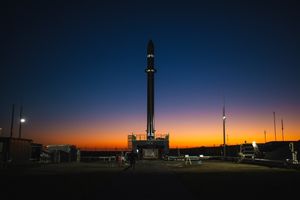Walmart to demonstrate 15-liter natural gas engine developed by Cummins
Chevron U.S.A. Inc., a subsidiary of Chevron Corporation (NYSE: CVX), today announced definitive agreements to supply fuel linked to renewable natural gas for a Walmart Inc. (NYSE: WMT) demonstration of Cummins Inc.’s (NYSE: CMI) new 15-liter natural gas engine for heavy-duty trucks.
As part of the agreements, Walmart will provide heavy-duty trucks for Cummins to integrate with the new 15-liter natural gas engine, the X15N™, which runs on compressed natural gas (CNG). After taking delivery, Walmart will field-test the finished trucks at its distribution center in Fontana, California, with Chevron supplying the trucks with CNG linked to renewable natural gas.
Renewable natural gas is produced when biomethane from decomposing organic matter – such as cow manure or landfill waste – is captured, treated and placed into the natural gas network. Uncaptured methane is more than 25 times as potent as carbon dioxide at trapping heat in the atmosphere. Chevron has partnerships with Brightmark LLC and California Bioenergy LLC to produce renewable natural gas from dairy farms, which under California’s Low Carbon Fuel Standard can qualify as carbon negative on a lifecycle basis. Chevron will be responsible for linking the renewable natural gas to the CNG dispensed by Walmart into its natural gas trucks.
“Chevron has positioned itself to help major fleet operators like Walmart in their efforts to decarbonize their transportation operations through the use of CNG linked to renewable natural gas,” said Andy Walz, president of Americas Fuels & Lubricants for Chevron. “As we continue to rapidly grow our renewable natural gas business, we aim to leverage the power of our partnerships to the benefit of new and existing customers who seek lower carbon transportation solutions.”
“Walmart’s collaboration with Chevron and Cummins on the new Cummins 15-liter natural gas engine is one of many technologies we are testing to reach zero emissions in our fleet, part of our broader goal to achieve zero emissions in our operations by 2040,” said Luke McCollum, vice president of Supply Chain Sustainability at Walmart. “Testing CNG linked to renewable natural gas marks a significant stepping stone for Walmart’s path to zero emissions transportation.”
In September 2021, Chevron and Cummins expanded their memorandum of understanding to include new strategic priorities relating to renewable natural gas, with an initial focus on making the transition to natural gas engines easier for fleets by improving fuel availability while allowing them to lower the lifecycle carbon intensity of their operations.
“Cummins is excited to work with Walmart and Chevron on heavy-duty natural gas trucks and fuel availability,” said Puneet Jhawar, general manager, Natural Gas at Cummins. “The Cummins X15N natural gas powertrain allows for fleets to significantly reduce their emissions footprint starting almost immediately on a large scale with competitive equipment costs, while providing the power, range, and performance characteristics customers expect from Cummins.”
About Chevron
Chevron is one of the world’s leading integrated energy companies. We believe affordable, reliable and ever-cleaner energy is essential to achieving a more prosperous and sustainable world. Chevron produces crude oil and natural gas; manufactures transportation fuels, lubricants, petrochemicals and additives; and develops technologies that enhance our business and the industry. We are focused on lowering the carbon intensity in our operations and seeking to grow lower carbon businesses along with our traditional business lines. More information about Chevron is available at www.chevron.com.
CAUTIONARY STATEMENTS RELEVANT TO FORWARD-LOOKING INFORMATION FOR THE PURPOSE OF “SAFE HARBOR” PROVISIONS OF THE PRIVATE SECURITIES LITIGATION REFORM ACT OF 1995
This news release contains forward-looking statements relating to Chevron’s operations and energy transition plans that are based on management's current expectations, estimates and projections about the petroleum, chemicals and other energy-related industries. Words or phrases such as “anticipates,” “expects,” “intends,” “plans,” “targets,” “advances,” “commits,” “drives,” “aims,” “forecasts,” “projects,” “believes,” “approaches,” “seeks,” “schedules,” “estimates,” “positions,” “pursues,” “may,” “can,” “could,” “should,” “will,” “budgets,” “outlook,” “trends,” “guidance,” “focus,” “on track,” “goals,” “objectives,” “strategies,” “opportunities,” “poised,” “potential,” “ambitions,” “aspires” and similar expressions are intended to identify such forward-looking statements. These statements are not guarantees of future performance and are subject to certain risks, uncertainties and other factors, many of which are beyond the company’s control and are difficult to predict. Therefore, actual outcomes and results may differ materially from what is expressed or forecasted in such forward-looking statements. The reader should not place undue reliance on these forward-looking statements, which speak only as of the date of this news release. Unless legally required, Chevron undertakes no obligation to update publicly any forward-looking statements, whether as a result of new information, future events or otherwise.
Among the important factors that could cause actual results to differ materially from those in the forward-looking statements are: changing crude oil and natural gas prices and demand for the company’s products, and production curtailments due to market conditions; crude oil production quotas or other actions that might be imposed by the Organization of Petroleum Exporting Countries and other producing countries; technological advancements; changes to government policies in the countries in which the company operates; public health crises, such as pandemics (including coronavirus (COVID-19)) and epidemics, and any related government policies and actions; disruptions in the company’s global supply chain, including supply chain constraints and escalation of the cost of goods and services; changing economic, regulatory and political environments in the various countries in which the company operates; general domestic and international economic and political conditions, including the military conflict between Russia and Ukraine and the global response to such conflict; changing refining, marketing and chemicals margins; actions of competitors or regulators; timing of exploration expenses; timing of crude oil liftings; the competitiveness of alternate-energy sources or product substitutes; development of large carbon capture and offset markets; the results of operations and financial condition of the company’s suppliers, vendors, partners and equity affiliates, particularly during the COVID-19 pandemic; the inability or failure of the company’s joint-venture partners to fund their share of operations and development activities; the potential failure to achieve expected net production from existing and future crude oil and natural gas development projects; potential delays in the development, construction or start-up of planned projects; the potential disruption or interruption of the company’s operations due to war, accidents, political events, civil unrest, severe weather, cyber threats, terrorist acts, or other natural or human causes beyond the company’s control; the potential liability for remedial actions or assessments under existing or future environmental regulations and litigation; significant operational, investment or product changes undertaken or required by existing or future environmental statutes and regulations, including international agreements and national or regional legislation and regulatory measures to limit or reduce greenhouse gas emissions; the potential liability resulting from pending or future litigation; the company’s future acquisitions or dispositions of assets or shares or the delay or failure of such transactions to close based on required closing conditions; the potential for gains and losses from asset dispositions or impairments; government mandated sales, divestitures, recapitalizations, taxes and tax audits, tariffs, sanctions, changes in fiscal terms or restrictions on scope of company operations; foreign currency movements compared with the U.S. dollar; material reductions in corporate liquidity and access to debt markets; the receipt of required Board authorizations to implement capital allocation strategies, including future stock repurchase programs and dividend payments; the effects of changed accounting rules under generally accepted accounting principles promulgated by rule-setting bodies; the company’s ability to identify and mitigate the risks and hazards inherent in operating in the global energy industry; and the factors set forth under the heading “Risk Factors” on pages 20 through 25 of the company’s 2021 Annual Report on Form 10-K and in subsequent filings with the U.S. Securities and Exchange Commission. Other unpredictable or unknown factors not discussed in this news release could also have material adverse effects on forward-looking statements.
View source version on businesswire.com: https://www.businesswire.com/news/home/20220608005176/en/
Contacts
Tyler Kruzich, Chevron External Affairs
TKruzich@chevron.com
t. (925) 549-8686





